Westpac Banking Corporation: Strategies, Issues, and Analysis Report
VerifiedAdded on 2020/05/28
|12
|2943
|116
Report
AI Summary
This report provides a comprehensive analysis of Westpac Banking Corporation, one of Australia's leading banks. It begins with an executive summary and table of contents, followed by an introduction that outlines the report's objectives. The report delves into Westpac's mission, vision, core competencies, and current and past strategies, including customer-focused, growth, and contingency approaches. It then examines two key controversies or issues faced by the bank, such as risk management and legal compliance. The report also includes a PESTLE analysis to assess the general environment and a SWOT analysis to identify strengths, weaknesses, opportunities, and threats. Finally, it discusses the culture and leadership style within Westpac, including the CEO's democratic leadership approach, and concludes with references. The report aims to provide a thorough understanding of Westpac's operations, strategies, and challenges in the competitive financial market.
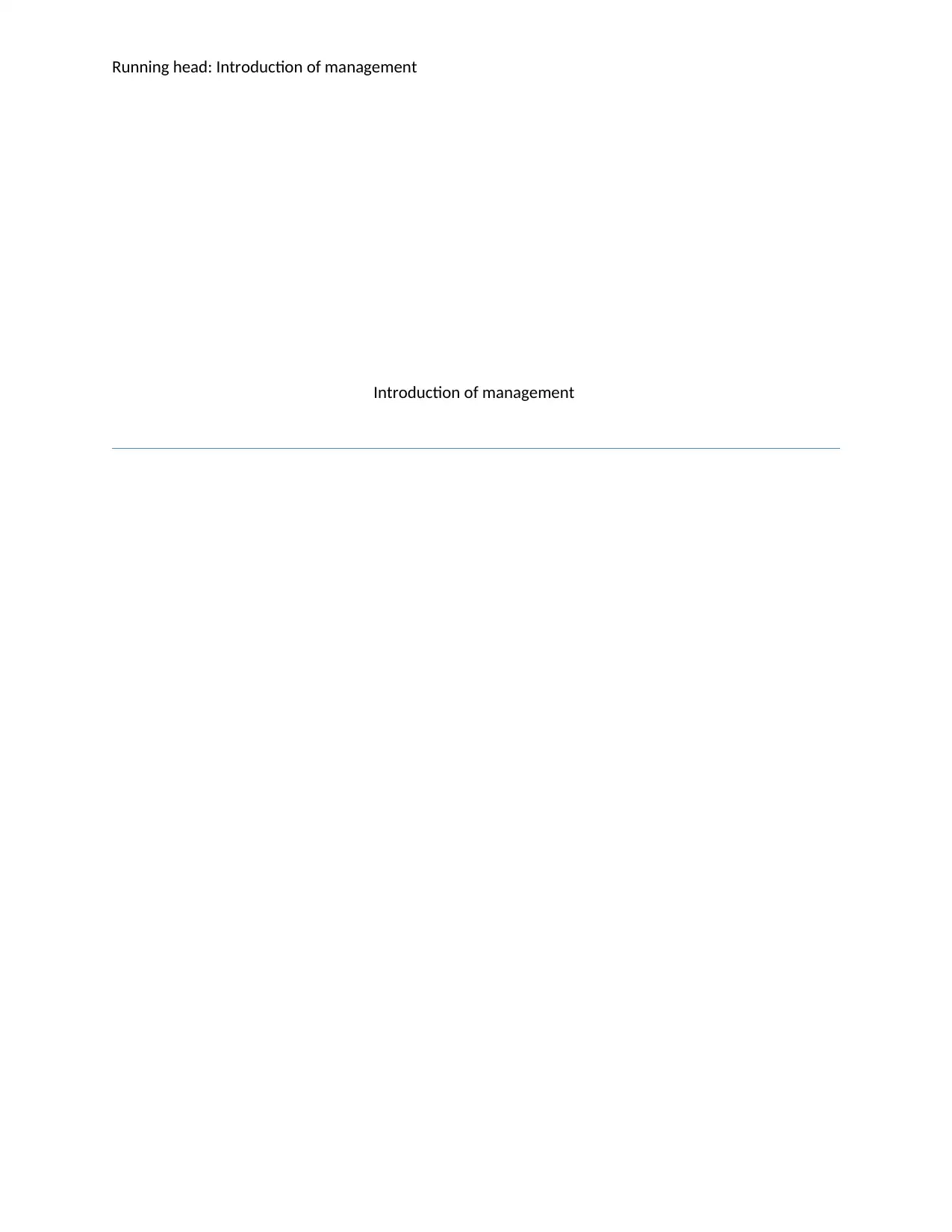
Running head: Introduction of management
Introduction of management
Introduction of management
Paraphrase This Document
Need a fresh take? Get an instant paraphrase of this document with our AI Paraphraser
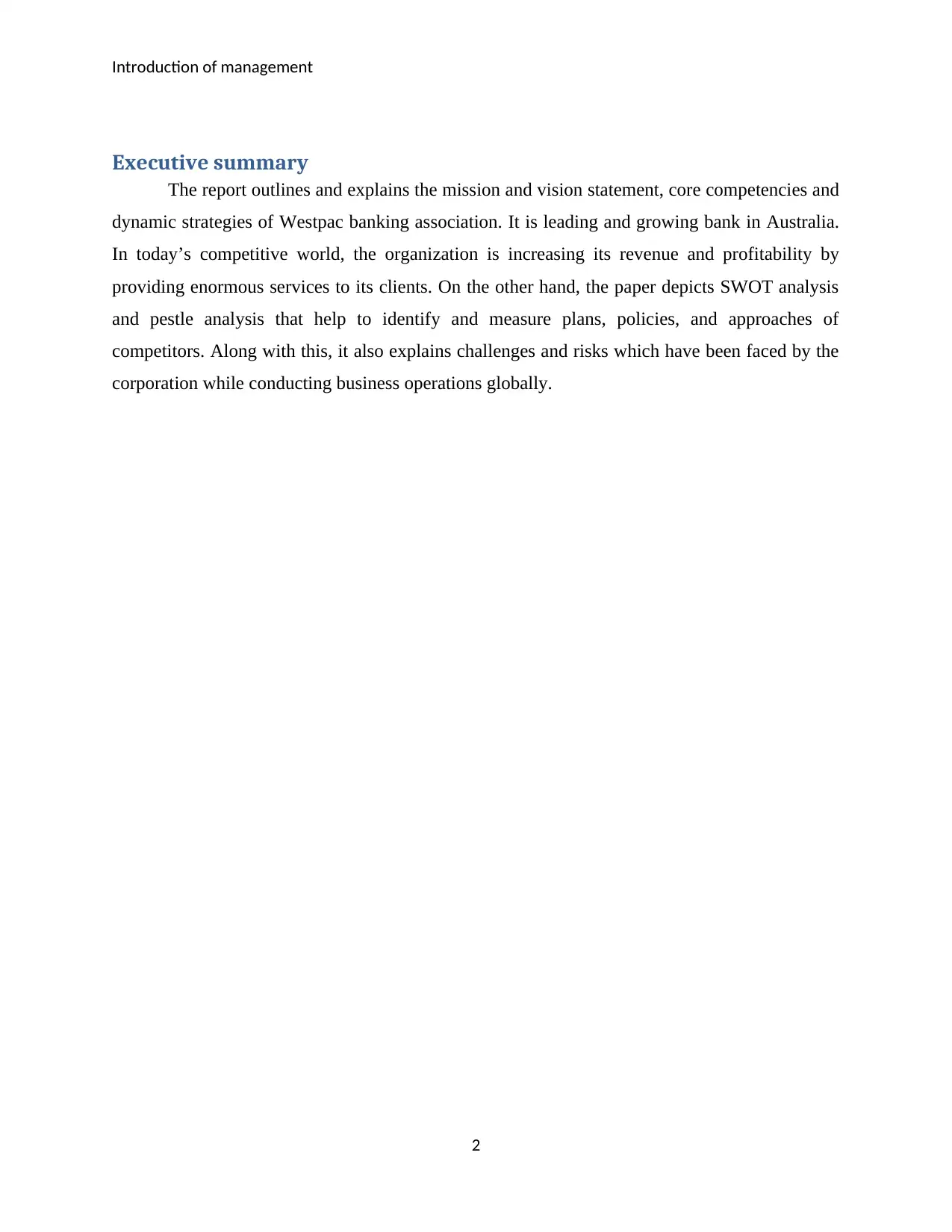
Introduction of management
Executive summary
The report outlines and explains the mission and vision statement, core competencies and
dynamic strategies of Westpac banking association. It is leading and growing bank in Australia.
In today’s competitive world, the organization is increasing its revenue and profitability by
providing enormous services to its clients. On the other hand, the paper depicts SWOT analysis
and pestle analysis that help to identify and measure plans, policies, and approaches of
competitors. Along with this, it also explains challenges and risks which have been faced by the
corporation while conducting business operations globally.
2
Executive summary
The report outlines and explains the mission and vision statement, core competencies and
dynamic strategies of Westpac banking association. It is leading and growing bank in Australia.
In today’s competitive world, the organization is increasing its revenue and profitability by
providing enormous services to its clients. On the other hand, the paper depicts SWOT analysis
and pestle analysis that help to identify and measure plans, policies, and approaches of
competitors. Along with this, it also explains challenges and risks which have been faced by the
corporation while conducting business operations globally.
2
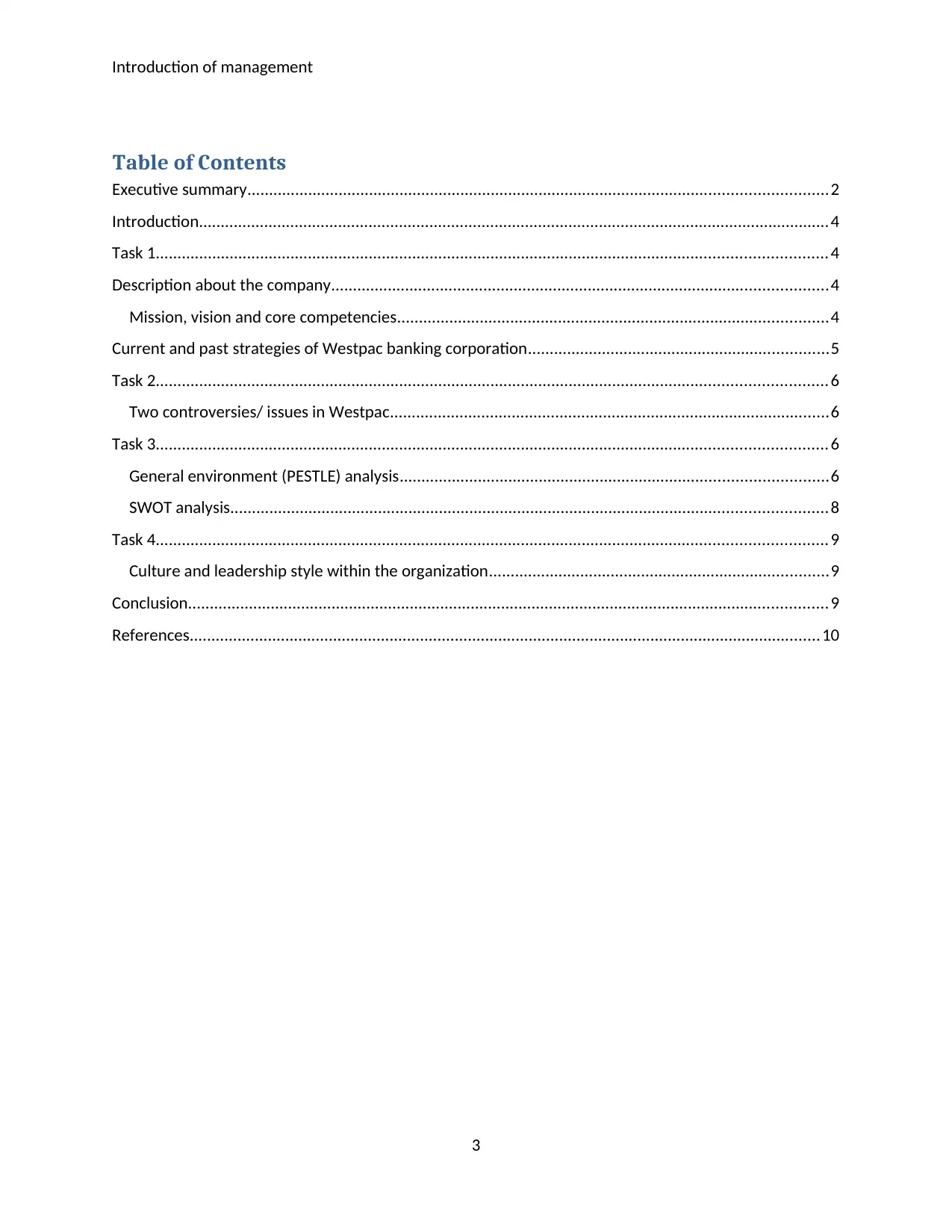
Introduction of management
Table of Contents
Executive summary.....................................................................................................................................2
Introduction.................................................................................................................................................4
Task 1..........................................................................................................................................................4
Description about the company..................................................................................................................4
Mission, vision and core competencies...................................................................................................4
Current and past strategies of Westpac banking corporation.....................................................................5
Task 2..........................................................................................................................................................6
Two controversies/ issues in Westpac.....................................................................................................6
Task 3..........................................................................................................................................................6
General environment (PESTLE) analysis..................................................................................................6
SWOT analysis.........................................................................................................................................8
Task 4..........................................................................................................................................................9
Culture and leadership style within the organization..............................................................................9
Conclusion...................................................................................................................................................9
References.................................................................................................................................................10
3
Table of Contents
Executive summary.....................................................................................................................................2
Introduction.................................................................................................................................................4
Task 1..........................................................................................................................................................4
Description about the company..................................................................................................................4
Mission, vision and core competencies...................................................................................................4
Current and past strategies of Westpac banking corporation.....................................................................5
Task 2..........................................................................................................................................................6
Two controversies/ issues in Westpac.....................................................................................................6
Task 3..........................................................................................................................................................6
General environment (PESTLE) analysis..................................................................................................6
SWOT analysis.........................................................................................................................................8
Task 4..........................................................................................................................................................9
Culture and leadership style within the organization..............................................................................9
Conclusion...................................................................................................................................................9
References.................................................................................................................................................10
3
⊘ This is a preview!⊘
Do you want full access?
Subscribe today to unlock all pages.

Trusted by 1+ million students worldwide
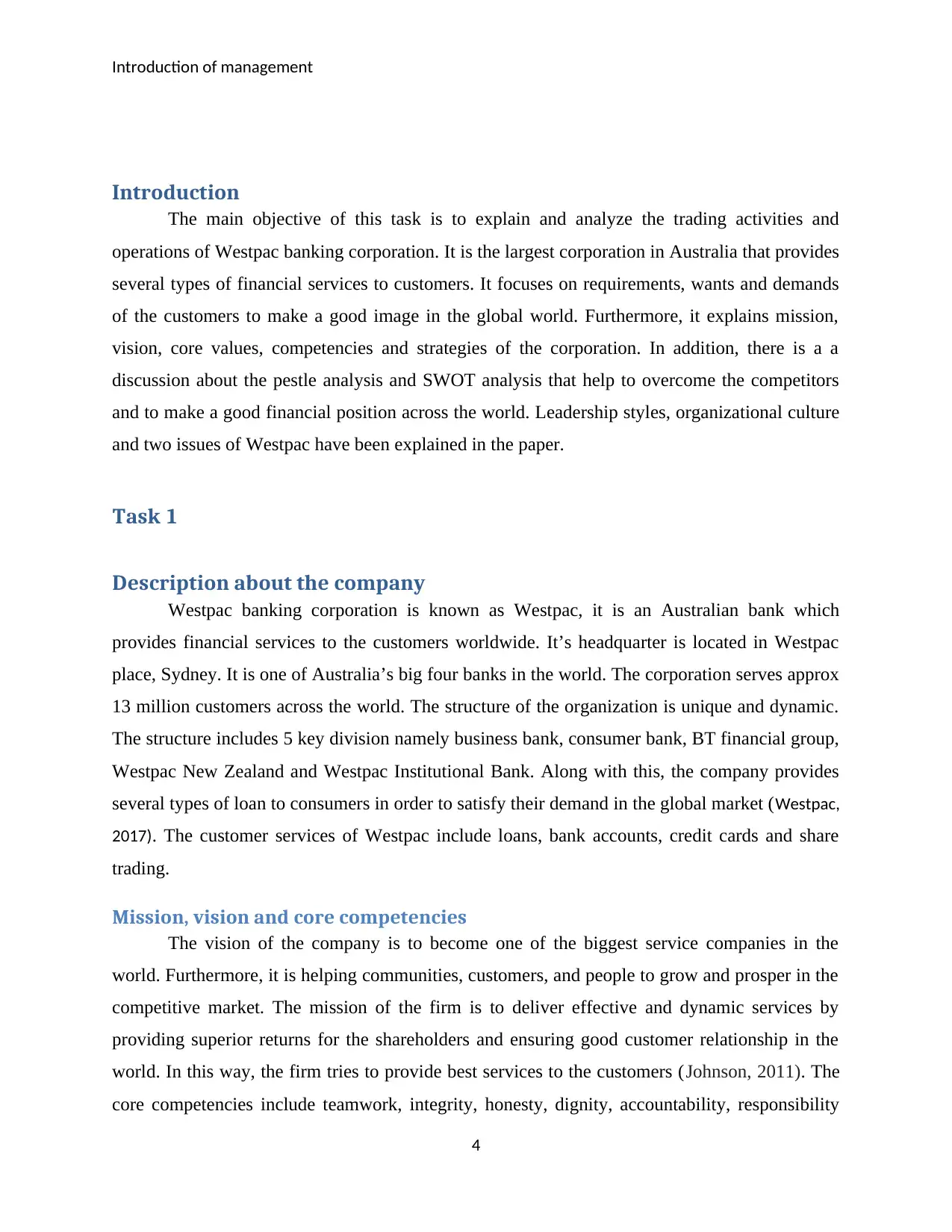
Introduction of management
Introduction
The main objective of this task is to explain and analyze the trading activities and
operations of Westpac banking corporation. It is the largest corporation in Australia that provides
several types of financial services to customers. It focuses on requirements, wants and demands
of the customers to make a good image in the global world. Furthermore, it explains mission,
vision, core values, competencies and strategies of the corporation. In addition, there is a a
discussion about the pestle analysis and SWOT analysis that help to overcome the competitors
and to make a good financial position across the world. Leadership styles, organizational culture
and two issues of Westpac have been explained in the paper.
Task 1
Description about the company
Westpac banking corporation is known as Westpac, it is an Australian bank which
provides financial services to the customers worldwide. It’s headquarter is located in Westpac
place, Sydney. It is one of Australia’s big four banks in the world. The corporation serves approx
13 million customers across the world. The structure of the organization is unique and dynamic.
The structure includes 5 key division namely business bank, consumer bank, BT financial group,
Westpac New Zealand and Westpac Institutional Bank. Along with this, the company provides
several types of loan to consumers in order to satisfy their demand in the global market (Westpac,
2017). The customer services of Westpac include loans, bank accounts, credit cards and share
trading.
Mission, vision and core competencies
The vision of the company is to become one of the biggest service companies in the
world. Furthermore, it is helping communities, customers, and people to grow and prosper in the
competitive market. The mission of the firm is to deliver effective and dynamic services by
providing superior returns for the shareholders and ensuring good customer relationship in the
world. In this way, the firm tries to provide best services to the customers (Johnson, 2011). The
core competencies include teamwork, integrity, honesty, dignity, accountability, responsibility
4
Introduction
The main objective of this task is to explain and analyze the trading activities and
operations of Westpac banking corporation. It is the largest corporation in Australia that provides
several types of financial services to customers. It focuses on requirements, wants and demands
of the customers to make a good image in the global world. Furthermore, it explains mission,
vision, core values, competencies and strategies of the corporation. In addition, there is a a
discussion about the pestle analysis and SWOT analysis that help to overcome the competitors
and to make a good financial position across the world. Leadership styles, organizational culture
and two issues of Westpac have been explained in the paper.
Task 1
Description about the company
Westpac banking corporation is known as Westpac, it is an Australian bank which
provides financial services to the customers worldwide. It’s headquarter is located in Westpac
place, Sydney. It is one of Australia’s big four banks in the world. The corporation serves approx
13 million customers across the world. The structure of the organization is unique and dynamic.
The structure includes 5 key division namely business bank, consumer bank, BT financial group,
Westpac New Zealand and Westpac Institutional Bank. Along with this, the company provides
several types of loan to consumers in order to satisfy their demand in the global market (Westpac,
2017). The customer services of Westpac include loans, bank accounts, credit cards and share
trading.
Mission, vision and core competencies
The vision of the company is to become one of the biggest service companies in the
world. Furthermore, it is helping communities, customers, and people to grow and prosper in the
competitive market. The mission of the firm is to deliver effective and dynamic services by
providing superior returns for the shareholders and ensuring good customer relationship in the
world. In this way, the firm tries to provide best services to the customers (Johnson, 2011). The
core competencies include teamwork, integrity, honesty, dignity, accountability, responsibility
4
Paraphrase This Document
Need a fresh take? Get an instant paraphrase of this document with our AI Paraphraser
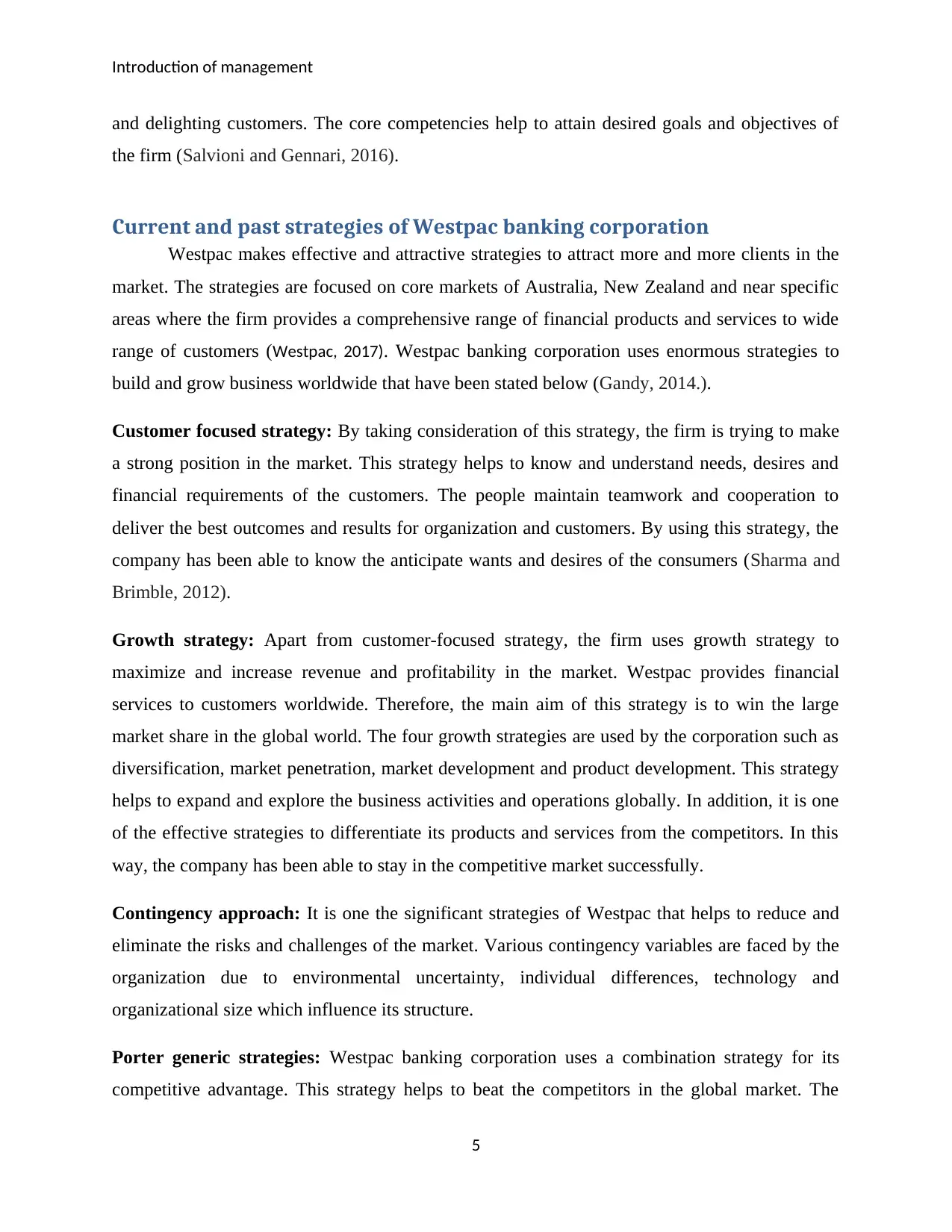
Introduction of management
and delighting customers. The core competencies help to attain desired goals and objectives of
the firm (Salvioni and Gennari, 2016).
Current and past strategies of Westpac banking corporation
Westpac makes effective and attractive strategies to attract more and more clients in the
market. The strategies are focused on core markets of Australia, New Zealand and near specific
areas where the firm provides a comprehensive range of financial products and services to wide
range of customers (Westpac, 2017). Westpac banking corporation uses enormous strategies to
build and grow business worldwide that have been stated below (Gandy, 2014.).
Customer focused strategy: By taking consideration of this strategy, the firm is trying to make
a strong position in the market. This strategy helps to know and understand needs, desires and
financial requirements of the customers. The people maintain teamwork and cooperation to
deliver the best outcomes and results for organization and customers. By using this strategy, the
company has been able to know the anticipate wants and desires of the consumers (Sharma and
Brimble, 2012).
Growth strategy: Apart from customer-focused strategy, the firm uses growth strategy to
maximize and increase revenue and profitability in the market. Westpac provides financial
services to customers worldwide. Therefore, the main aim of this strategy is to win the large
market share in the global world. The four growth strategies are used by the corporation such as
diversification, market penetration, market development and product development. This strategy
helps to expand and explore the business activities and operations globally. In addition, it is one
of the effective strategies to differentiate its products and services from the competitors. In this
way, the company has been able to stay in the competitive market successfully.
Contingency approach: It is one the significant strategies of Westpac that helps to reduce and
eliminate the risks and challenges of the market. Various contingency variables are faced by the
organization due to environmental uncertainty, individual differences, technology and
organizational size which influence its structure.
Porter generic strategies: Westpac banking corporation uses a combination strategy for its
competitive advantage. This strategy helps to beat the competitors in the global market. The
5
and delighting customers. The core competencies help to attain desired goals and objectives of
the firm (Salvioni and Gennari, 2016).
Current and past strategies of Westpac banking corporation
Westpac makes effective and attractive strategies to attract more and more clients in the
market. The strategies are focused on core markets of Australia, New Zealand and near specific
areas where the firm provides a comprehensive range of financial products and services to wide
range of customers (Westpac, 2017). Westpac banking corporation uses enormous strategies to
build and grow business worldwide that have been stated below (Gandy, 2014.).
Customer focused strategy: By taking consideration of this strategy, the firm is trying to make
a strong position in the market. This strategy helps to know and understand needs, desires and
financial requirements of the customers. The people maintain teamwork and cooperation to
deliver the best outcomes and results for organization and customers. By using this strategy, the
company has been able to know the anticipate wants and desires of the consumers (Sharma and
Brimble, 2012).
Growth strategy: Apart from customer-focused strategy, the firm uses growth strategy to
maximize and increase revenue and profitability in the market. Westpac provides financial
services to customers worldwide. Therefore, the main aim of this strategy is to win the large
market share in the global world. The four growth strategies are used by the corporation such as
diversification, market penetration, market development and product development. This strategy
helps to expand and explore the business activities and operations globally. In addition, it is one
of the effective strategies to differentiate its products and services from the competitors. In this
way, the company has been able to stay in the competitive market successfully.
Contingency approach: It is one the significant strategies of Westpac that helps to reduce and
eliminate the risks and challenges of the market. Various contingency variables are faced by the
organization due to environmental uncertainty, individual differences, technology and
organizational size which influence its structure.
Porter generic strategies: Westpac banking corporation uses a combination strategy for its
competitive advantage. This strategy helps to beat the competitors in the global market. The
5
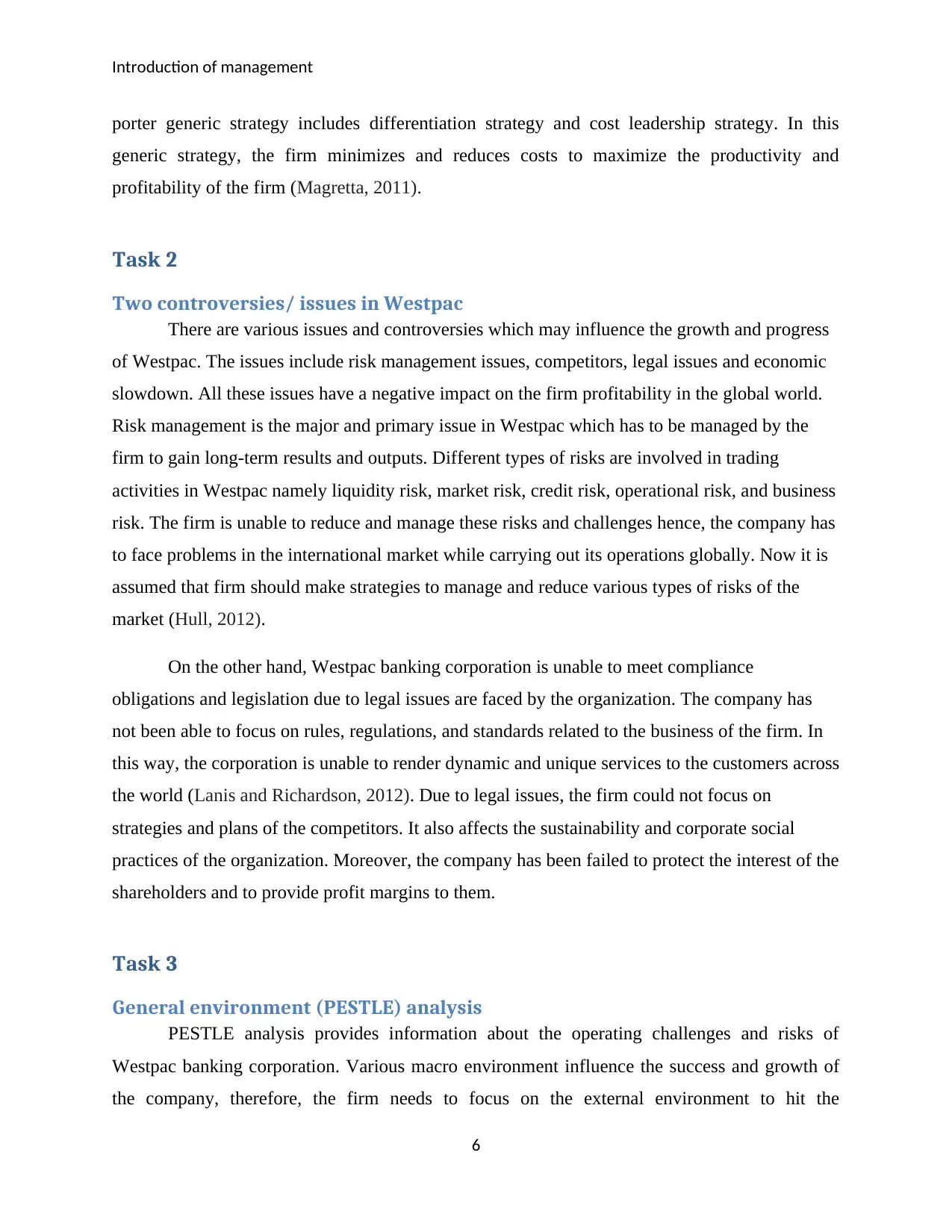
Introduction of management
porter generic strategy includes differentiation strategy and cost leadership strategy. In this
generic strategy, the firm minimizes and reduces costs to maximize the productivity and
profitability of the firm (Magretta, 2011).
Task 2
Two controversies/ issues in Westpac
There are various issues and controversies which may influence the growth and progress
of Westpac. The issues include risk management issues, competitors, legal issues and economic
slowdown. All these issues have a negative impact on the firm profitability in the global world.
Risk management is the major and primary issue in Westpac which has to be managed by the
firm to gain long-term results and outputs. Different types of risks are involved in trading
activities in Westpac namely liquidity risk, market risk, credit risk, operational risk, and business
risk. The firm is unable to reduce and manage these risks and challenges hence, the company has
to face problems in the international market while carrying out its operations globally. Now it is
assumed that firm should make strategies to manage and reduce various types of risks of the
market (Hull, 2012).
On the other hand, Westpac banking corporation is unable to meet compliance
obligations and legislation due to legal issues are faced by the organization. The company has
not been able to focus on rules, regulations, and standards related to the business of the firm. In
this way, the corporation is unable to render dynamic and unique services to the customers across
the world (Lanis and Richardson, 2012). Due to legal issues, the firm could not focus on
strategies and plans of the competitors. It also affects the sustainability and corporate social
practices of the organization. Moreover, the company has been failed to protect the interest of the
shareholders and to provide profit margins to them.
Task 3
General environment (PESTLE) analysis
PESTLE analysis provides information about the operating challenges and risks of
Westpac banking corporation. Various macro environment influence the success and growth of
the company, therefore, the firm needs to focus on the external environment to hit the
6
porter generic strategy includes differentiation strategy and cost leadership strategy. In this
generic strategy, the firm minimizes and reduces costs to maximize the productivity and
profitability of the firm (Magretta, 2011).
Task 2
Two controversies/ issues in Westpac
There are various issues and controversies which may influence the growth and progress
of Westpac. The issues include risk management issues, competitors, legal issues and economic
slowdown. All these issues have a negative impact on the firm profitability in the global world.
Risk management is the major and primary issue in Westpac which has to be managed by the
firm to gain long-term results and outputs. Different types of risks are involved in trading
activities in Westpac namely liquidity risk, market risk, credit risk, operational risk, and business
risk. The firm is unable to reduce and manage these risks and challenges hence, the company has
to face problems in the international market while carrying out its operations globally. Now it is
assumed that firm should make strategies to manage and reduce various types of risks of the
market (Hull, 2012).
On the other hand, Westpac banking corporation is unable to meet compliance
obligations and legislation due to legal issues are faced by the organization. The company has
not been able to focus on rules, regulations, and standards related to the business of the firm. In
this way, the corporation is unable to render dynamic and unique services to the customers across
the world (Lanis and Richardson, 2012). Due to legal issues, the firm could not focus on
strategies and plans of the competitors. It also affects the sustainability and corporate social
practices of the organization. Moreover, the company has been failed to protect the interest of the
shareholders and to provide profit margins to them.
Task 3
General environment (PESTLE) analysis
PESTLE analysis provides information about the operating challenges and risks of
Westpac banking corporation. Various macro environment influence the success and growth of
the company, therefore, the firm needs to focus on the external environment to hit the
6
⊘ This is a preview!⊘
Do you want full access?
Subscribe today to unlock all pages.

Trusted by 1+ million students worldwide
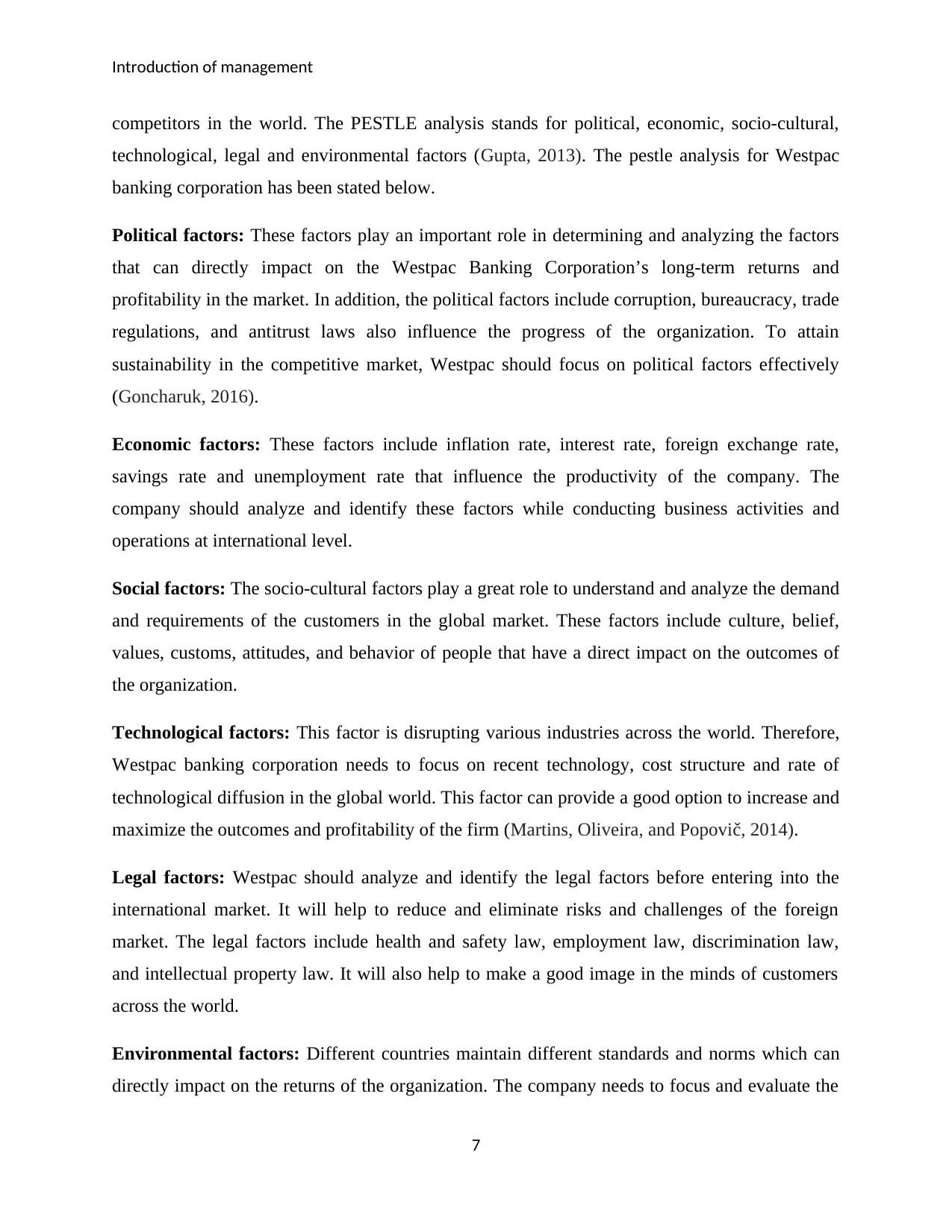
Introduction of management
competitors in the world. The PESTLE analysis stands for political, economic, socio-cultural,
technological, legal and environmental factors (Gupta, 2013). The pestle analysis for Westpac
banking corporation has been stated below.
Political factors: These factors play an important role in determining and analyzing the factors
that can directly impact on the Westpac Banking Corporation’s long-term returns and
profitability in the market. In addition, the political factors include corruption, bureaucracy, trade
regulations, and antitrust laws also influence the progress of the organization. To attain
sustainability in the competitive market, Westpac should focus on political factors effectively
(Goncharuk, 2016).
Economic factors: These factors include inflation rate, interest rate, foreign exchange rate,
savings rate and unemployment rate that influence the productivity of the company. The
company should analyze and identify these factors while conducting business activities and
operations at international level.
Social factors: The socio-cultural factors play a great role to understand and analyze the demand
and requirements of the customers in the global market. These factors include culture, belief,
values, customs, attitudes, and behavior of people that have a direct impact on the outcomes of
the organization.
Technological factors: This factor is disrupting various industries across the world. Therefore,
Westpac banking corporation needs to focus on recent technology, cost structure and rate of
technological diffusion in the global world. This factor can provide a good option to increase and
maximize the outcomes and profitability of the firm (Martins, Oliveira, and Popovič, 2014).
Legal factors: Westpac should analyze and identify the legal factors before entering into the
international market. It will help to reduce and eliminate risks and challenges of the foreign
market. The legal factors include health and safety law, employment law, discrimination law,
and intellectual property law. It will also help to make a good image in the minds of customers
across the world.
Environmental factors: Different countries maintain different standards and norms which can
directly impact on the returns of the organization. The company needs to focus and evaluate the
7
competitors in the world. The PESTLE analysis stands for political, economic, socio-cultural,
technological, legal and environmental factors (Gupta, 2013). The pestle analysis for Westpac
banking corporation has been stated below.
Political factors: These factors play an important role in determining and analyzing the factors
that can directly impact on the Westpac Banking Corporation’s long-term returns and
profitability in the market. In addition, the political factors include corruption, bureaucracy, trade
regulations, and antitrust laws also influence the progress of the organization. To attain
sustainability in the competitive market, Westpac should focus on political factors effectively
(Goncharuk, 2016).
Economic factors: These factors include inflation rate, interest rate, foreign exchange rate,
savings rate and unemployment rate that influence the productivity of the company. The
company should analyze and identify these factors while conducting business activities and
operations at international level.
Social factors: The socio-cultural factors play a great role to understand and analyze the demand
and requirements of the customers in the global market. These factors include culture, belief,
values, customs, attitudes, and behavior of people that have a direct impact on the outcomes of
the organization.
Technological factors: This factor is disrupting various industries across the world. Therefore,
Westpac banking corporation needs to focus on recent technology, cost structure and rate of
technological diffusion in the global world. This factor can provide a good option to increase and
maximize the outcomes and profitability of the firm (Martins, Oliveira, and Popovič, 2014).
Legal factors: Westpac should analyze and identify the legal factors before entering into the
international market. It will help to reduce and eliminate risks and challenges of the foreign
market. The legal factors include health and safety law, employment law, discrimination law,
and intellectual property law. It will also help to make a good image in the minds of customers
across the world.
Environmental factors: Different countries maintain different standards and norms which can
directly impact on the returns of the organization. The company needs to focus and evaluate the
7
Paraphrase This Document
Need a fresh take? Get an instant paraphrase of this document with our AI Paraphraser
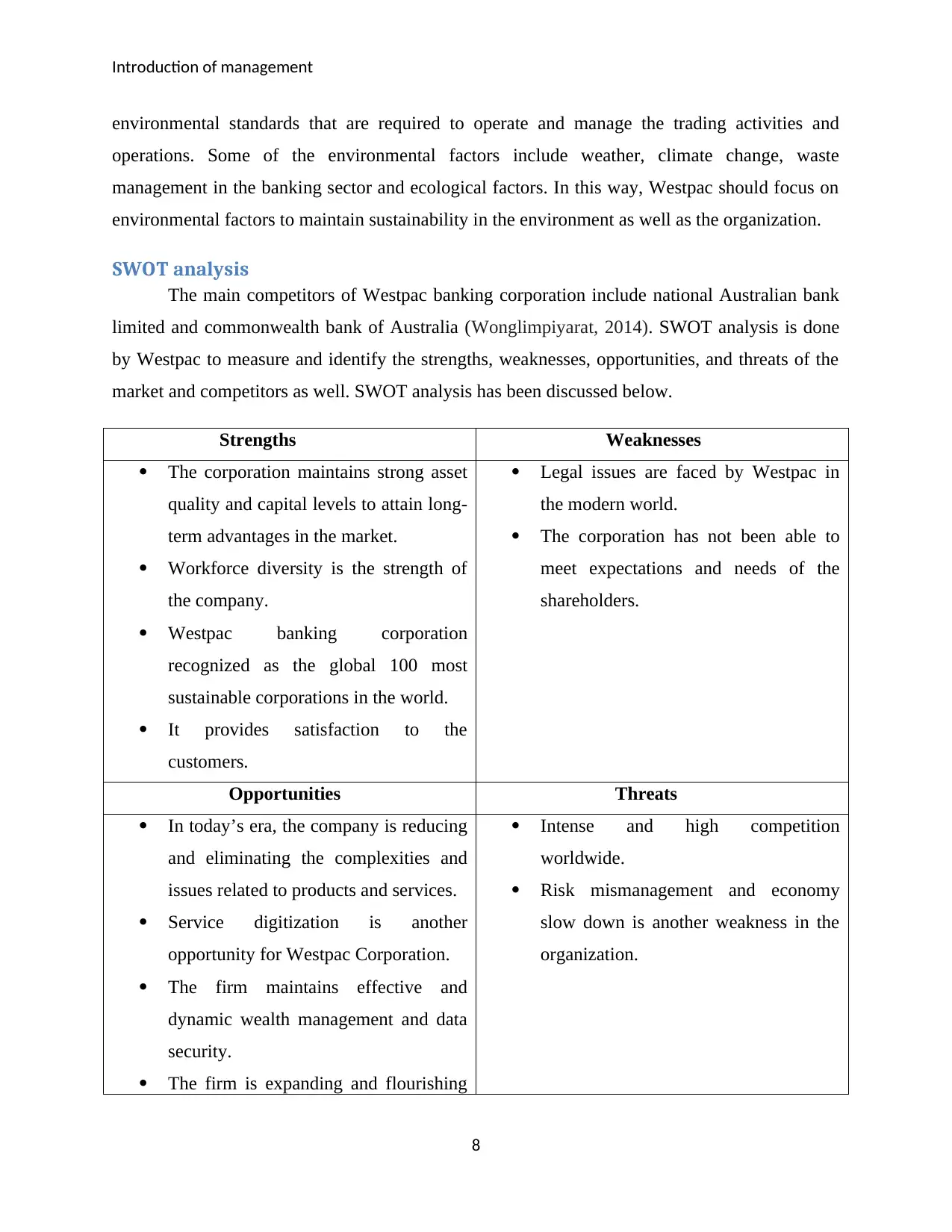
Introduction of management
environmental standards that are required to operate and manage the trading activities and
operations. Some of the environmental factors include weather, climate change, waste
management in the banking sector and ecological factors. In this way, Westpac should focus on
environmental factors to maintain sustainability in the environment as well as the organization.
SWOT analysis
The main competitors of Westpac banking corporation include national Australian bank
limited and commonwealth bank of Australia (Wonglimpiyarat, 2014). SWOT analysis is done
by Westpac to measure and identify the strengths, weaknesses, opportunities, and threats of the
market and competitors as well. SWOT analysis has been discussed below.
Strengths Weaknesses
The corporation maintains strong asset
quality and capital levels to attain long-
term advantages in the market.
Workforce diversity is the strength of
the company.
Westpac banking corporation
recognized as the global 100 most
sustainable corporations in the world.
It provides satisfaction to the
customers.
Legal issues are faced by Westpac in
the modern world.
The corporation has not been able to
meet expectations and needs of the
shareholders.
Opportunities Threats
In today’s era, the company is reducing
and eliminating the complexities and
issues related to products and services.
Service digitization is another
opportunity for Westpac Corporation.
The firm maintains effective and
dynamic wealth management and data
security.
The firm is expanding and flourishing
Intense and high competition
worldwide.
Risk mismanagement and economy
slow down is another weakness in the
organization.
8
environmental standards that are required to operate and manage the trading activities and
operations. Some of the environmental factors include weather, climate change, waste
management in the banking sector and ecological factors. In this way, Westpac should focus on
environmental factors to maintain sustainability in the environment as well as the organization.
SWOT analysis
The main competitors of Westpac banking corporation include national Australian bank
limited and commonwealth bank of Australia (Wonglimpiyarat, 2014). SWOT analysis is done
by Westpac to measure and identify the strengths, weaknesses, opportunities, and threats of the
market and competitors as well. SWOT analysis has been discussed below.
Strengths Weaknesses
The corporation maintains strong asset
quality and capital levels to attain long-
term advantages in the market.
Workforce diversity is the strength of
the company.
Westpac banking corporation
recognized as the global 100 most
sustainable corporations in the world.
It provides satisfaction to the
customers.
Legal issues are faced by Westpac in
the modern world.
The corporation has not been able to
meet expectations and needs of the
shareholders.
Opportunities Threats
In today’s era, the company is reducing
and eliminating the complexities and
issues related to products and services.
Service digitization is another
opportunity for Westpac Corporation.
The firm maintains effective and
dynamic wealth management and data
security.
The firm is expanding and flourishing
Intense and high competition
worldwide.
Risk mismanagement and economy
slow down is another weakness in the
organization.
8
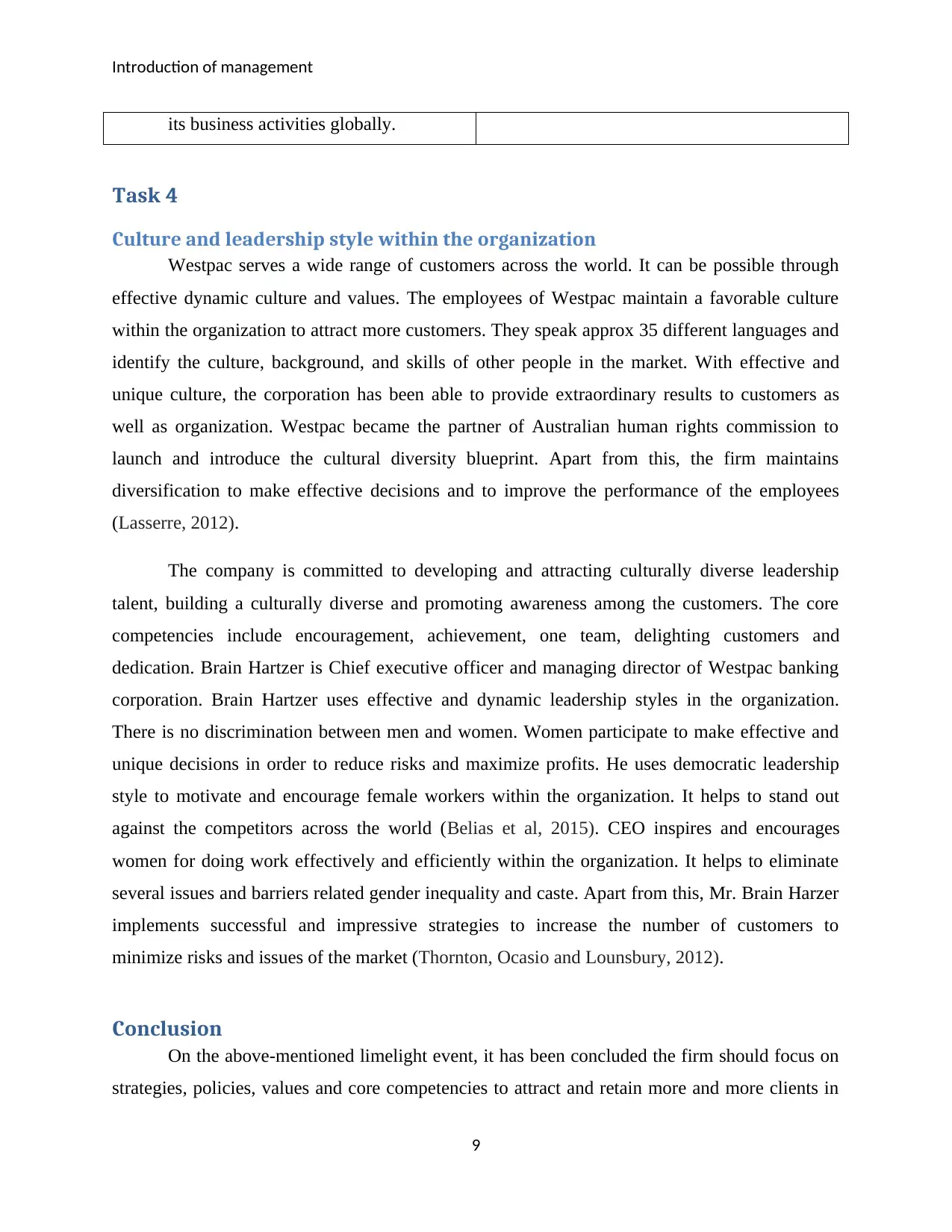
Introduction of management
its business activities globally.
Task 4
Culture and leadership style within the organization
Westpac serves a wide range of customers across the world. It can be possible through
effective dynamic culture and values. The employees of Westpac maintain a favorable culture
within the organization to attract more customers. They speak approx 35 different languages and
identify the culture, background, and skills of other people in the market. With effective and
unique culture, the corporation has been able to provide extraordinary results to customers as
well as organization. Westpac became the partner of Australian human rights commission to
launch and introduce the cultural diversity blueprint. Apart from this, the firm maintains
diversification to make effective decisions and to improve the performance of the employees
(Lasserre, 2012).
The company is committed to developing and attracting culturally diverse leadership
talent, building a culturally diverse and promoting awareness among the customers. The core
competencies include encouragement, achievement, one team, delighting customers and
dedication. Brain Hartzer is Chief executive officer and managing director of Westpac banking
corporation. Brain Hartzer uses effective and dynamic leadership styles in the organization.
There is no discrimination between men and women. Women participate to make effective and
unique decisions in order to reduce risks and maximize profits. He uses democratic leadership
style to motivate and encourage female workers within the organization. It helps to stand out
against the competitors across the world (Belias et al, 2015). CEO inspires and encourages
women for doing work effectively and efficiently within the organization. It helps to eliminate
several issues and barriers related gender inequality and caste. Apart from this, Mr. Brain Harzer
implements successful and impressive strategies to increase the number of customers to
minimize risks and issues of the market (Thornton, Ocasio and Lounsbury, 2012).
Conclusion
On the above-mentioned limelight event, it has been concluded the firm should focus on
strategies, policies, values and core competencies to attract and retain more and more clients in
9
its business activities globally.
Task 4
Culture and leadership style within the organization
Westpac serves a wide range of customers across the world. It can be possible through
effective dynamic culture and values. The employees of Westpac maintain a favorable culture
within the organization to attract more customers. They speak approx 35 different languages and
identify the culture, background, and skills of other people in the market. With effective and
unique culture, the corporation has been able to provide extraordinary results to customers as
well as organization. Westpac became the partner of Australian human rights commission to
launch and introduce the cultural diversity blueprint. Apart from this, the firm maintains
diversification to make effective decisions and to improve the performance of the employees
(Lasserre, 2012).
The company is committed to developing and attracting culturally diverse leadership
talent, building a culturally diverse and promoting awareness among the customers. The core
competencies include encouragement, achievement, one team, delighting customers and
dedication. Brain Hartzer is Chief executive officer and managing director of Westpac banking
corporation. Brain Hartzer uses effective and dynamic leadership styles in the organization.
There is no discrimination between men and women. Women participate to make effective and
unique decisions in order to reduce risks and maximize profits. He uses democratic leadership
style to motivate and encourage female workers within the organization. It helps to stand out
against the competitors across the world (Belias et al, 2015). CEO inspires and encourages
women for doing work effectively and efficiently within the organization. It helps to eliminate
several issues and barriers related gender inequality and caste. Apart from this, Mr. Brain Harzer
implements successful and impressive strategies to increase the number of customers to
minimize risks and issues of the market (Thornton, Ocasio and Lounsbury, 2012).
Conclusion
On the above-mentioned limelight event, it has been concluded the firm should focus on
strategies, policies, values and core competencies to attract and retain more and more clients in
9
⊘ This is a preview!⊘
Do you want full access?
Subscribe today to unlock all pages.

Trusted by 1+ million students worldwide
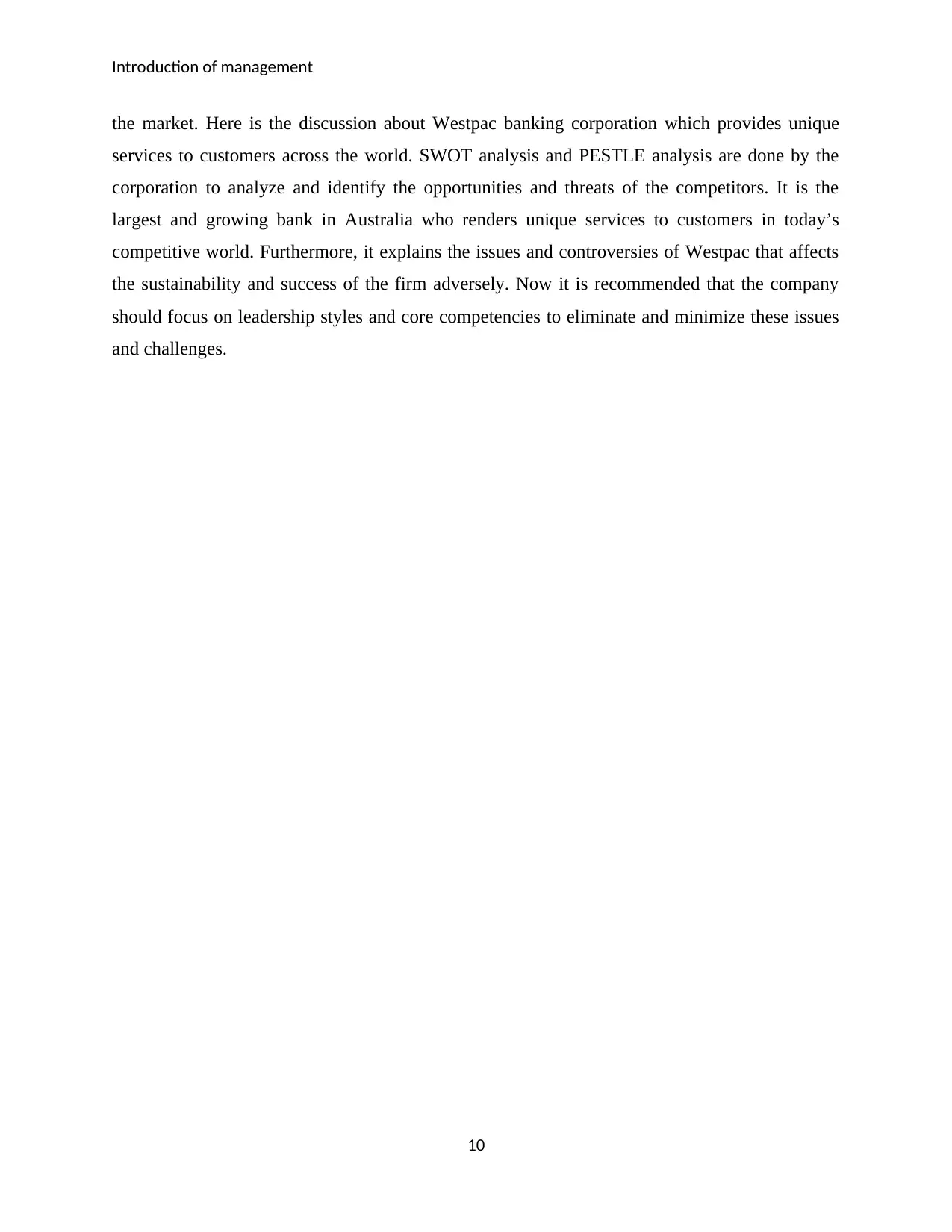
Introduction of management
the market. Here is the discussion about Westpac banking corporation which provides unique
services to customers across the world. SWOT analysis and PESTLE analysis are done by the
corporation to analyze and identify the opportunities and threats of the competitors. It is the
largest and growing bank in Australia who renders unique services to customers in today’s
competitive world. Furthermore, it explains the issues and controversies of Westpac that affects
the sustainability and success of the firm adversely. Now it is recommended that the company
should focus on leadership styles and core competencies to eliminate and minimize these issues
and challenges.
10
the market. Here is the discussion about Westpac banking corporation which provides unique
services to customers across the world. SWOT analysis and PESTLE analysis are done by the
corporation to analyze and identify the opportunities and threats of the competitors. It is the
largest and growing bank in Australia who renders unique services to customers in today’s
competitive world. Furthermore, it explains the issues and controversies of Westpac that affects
the sustainability and success of the firm adversely. Now it is recommended that the company
should focus on leadership styles and core competencies to eliminate and minimize these issues
and challenges.
10
Paraphrase This Document
Need a fresh take? Get an instant paraphrase of this document with our AI Paraphraser
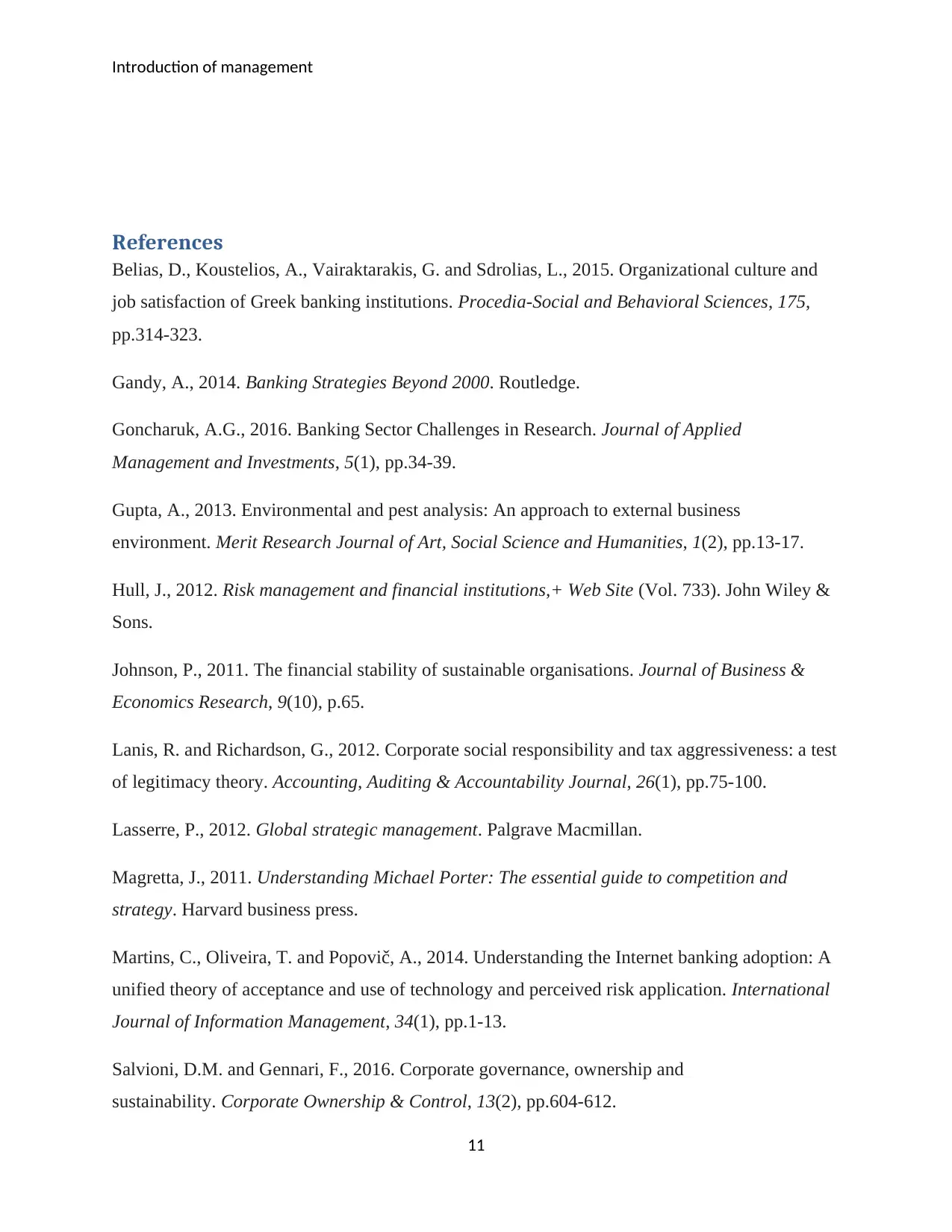
Introduction of management
References
Belias, D., Koustelios, A., Vairaktarakis, G. and Sdrolias, L., 2015. Organizational culture and
job satisfaction of Greek banking institutions. Procedia-Social and Behavioral Sciences, 175,
pp.314-323.
Gandy, A., 2014. Banking Strategies Beyond 2000. Routledge.
Goncharuk, A.G., 2016. Banking Sector Challenges in Research. Journal of Applied
Management and Investments, 5(1), pp.34-39.
Gupta, A., 2013. Environmental and pest analysis: An approach to external business
environment. Merit Research Journal of Art, Social Science and Humanities, 1(2), pp.13-17.
Hull, J., 2012. Risk management and financial institutions,+ Web Site (Vol. 733). John Wiley &
Sons.
Johnson, P., 2011. The financial stability of sustainable organisations. Journal of Business &
Economics Research, 9(10), p.65.
Lanis, R. and Richardson, G., 2012. Corporate social responsibility and tax aggressiveness: a test
of legitimacy theory. Accounting, Auditing & Accountability Journal, 26(1), pp.75-100.
Lasserre, P., 2012. Global strategic management. Palgrave Macmillan.
Magretta, J., 2011. Understanding Michael Porter: The essential guide to competition and
strategy. Harvard business press.
Martins, C., Oliveira, T. and Popovič, A., 2014. Understanding the Internet banking adoption: A
unified theory of acceptance and use of technology and perceived risk application. International
Journal of Information Management, 34(1), pp.1-13.
Salvioni, D.M. and Gennari, F., 2016. Corporate governance, ownership and
sustainability. Corporate Ownership & Control, 13(2), pp.604-612.
11
References
Belias, D., Koustelios, A., Vairaktarakis, G. and Sdrolias, L., 2015. Organizational culture and
job satisfaction of Greek banking institutions. Procedia-Social and Behavioral Sciences, 175,
pp.314-323.
Gandy, A., 2014. Banking Strategies Beyond 2000. Routledge.
Goncharuk, A.G., 2016. Banking Sector Challenges in Research. Journal of Applied
Management and Investments, 5(1), pp.34-39.
Gupta, A., 2013. Environmental and pest analysis: An approach to external business
environment. Merit Research Journal of Art, Social Science and Humanities, 1(2), pp.13-17.
Hull, J., 2012. Risk management and financial institutions,+ Web Site (Vol. 733). John Wiley &
Sons.
Johnson, P., 2011. The financial stability of sustainable organisations. Journal of Business &
Economics Research, 9(10), p.65.
Lanis, R. and Richardson, G., 2012. Corporate social responsibility and tax aggressiveness: a test
of legitimacy theory. Accounting, Auditing & Accountability Journal, 26(1), pp.75-100.
Lasserre, P., 2012. Global strategic management. Palgrave Macmillan.
Magretta, J., 2011. Understanding Michael Porter: The essential guide to competition and
strategy. Harvard business press.
Martins, C., Oliveira, T. and Popovič, A., 2014. Understanding the Internet banking adoption: A
unified theory of acceptance and use of technology and perceived risk application. International
Journal of Information Management, 34(1), pp.1-13.
Salvioni, D.M. and Gennari, F., 2016. Corporate governance, ownership and
sustainability. Corporate Ownership & Control, 13(2), pp.604-612.
11
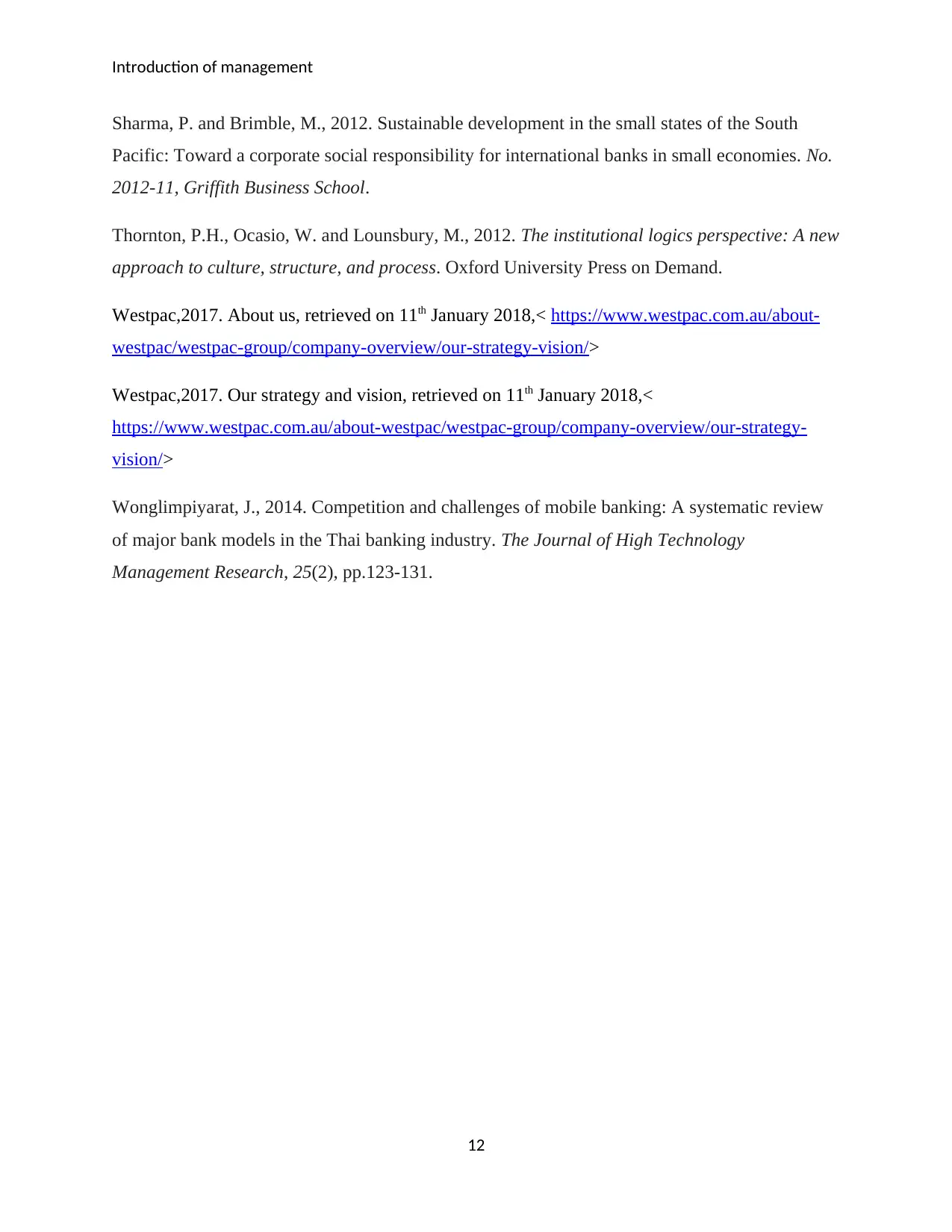
Introduction of management
Sharma, P. and Brimble, M., 2012. Sustainable development in the small states of the South
Pacific: Toward a corporate social responsibility for international banks in small economies. No.
2012-11, Griffith Business School.
Thornton, P.H., Ocasio, W. and Lounsbury, M., 2012. The institutional logics perspective: A new
approach to culture, structure, and process. Oxford University Press on Demand.
Westpac,2017. About us, retrieved on 11th January 2018,< https://www.westpac.com.au/about-
westpac/westpac-group/company-overview/our-strategy-vision/>
Westpac,2017. Our strategy and vision, retrieved on 11th January 2018,<
https://www.westpac.com.au/about-westpac/westpac-group/company-overview/our-strategy-
vision/>
Wonglimpiyarat, J., 2014. Competition and challenges of mobile banking: A systematic review
of major bank models in the Thai banking industry. The Journal of High Technology
Management Research, 25(2), pp.123-131.
12
Sharma, P. and Brimble, M., 2012. Sustainable development in the small states of the South
Pacific: Toward a corporate social responsibility for international banks in small economies. No.
2012-11, Griffith Business School.
Thornton, P.H., Ocasio, W. and Lounsbury, M., 2012. The institutional logics perspective: A new
approach to culture, structure, and process. Oxford University Press on Demand.
Westpac,2017. About us, retrieved on 11th January 2018,< https://www.westpac.com.au/about-
westpac/westpac-group/company-overview/our-strategy-vision/>
Westpac,2017. Our strategy and vision, retrieved on 11th January 2018,<
https://www.westpac.com.au/about-westpac/westpac-group/company-overview/our-strategy-
vision/>
Wonglimpiyarat, J., 2014. Competition and challenges of mobile banking: A systematic review
of major bank models in the Thai banking industry. The Journal of High Technology
Management Research, 25(2), pp.123-131.
12
⊘ This is a preview!⊘
Do you want full access?
Subscribe today to unlock all pages.

Trusted by 1+ million students worldwide
1 out of 12
Related Documents
Your All-in-One AI-Powered Toolkit for Academic Success.
+13062052269
info@desklib.com
Available 24*7 on WhatsApp / Email
![[object Object]](/_next/static/media/star-bottom.7253800d.svg)
Unlock your academic potential
Copyright © 2020–2025 A2Z Services. All Rights Reserved. Developed and managed by ZUCOL.





